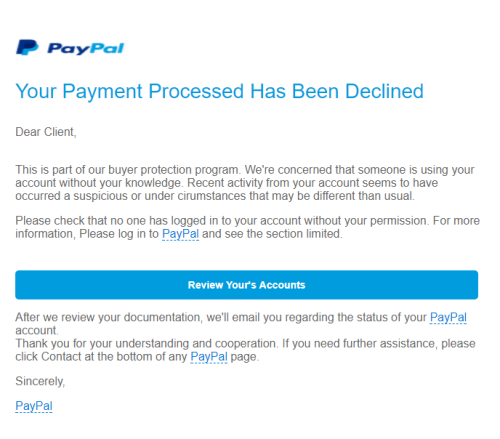petermorwood:justhere4coffee:amphiaria:amphiaria:this is the most sophisticated phishing e-mail I ha
petermorwood:justhere4coffee:amphiaria:amphiaria:this is the most sophisticated phishing e-mail I have ever received and if they had sized the logo correctly and actually proofread the fucking thing I probably would’ve clicked that buttonactually please reblog this because someone else got it too. do not click on the links in this e-mail if you get one like it, just forward it to spoof@paypal.com and delete it“Review Your’s Accounts” was a big hint, but there was one glaring mistake, even bigger than the wrongly-sized logo, and it’s one that can never be fixed by scammers:Top tip - Paypal, and indeed almost every legitimate business you have email contact with, will always use your name rather than a generic honorific like “client” or “Sir/Madam”.If it doesn’t say your name anywhere in the message, do not trust it.First thought: Ho-ho, that clunky English is a dead giveaway.Second thought: If English wasn’t my first language would I notice the clunks? As @justhere4coffee points out, real business contacts address you by the name you gave them when you signed up (and it wasn’t Sir/Madam Client, was it…?)Here’s another tip: When you hover your cursor over a click-button, the destination URL will appear on a pop-up or at the bottom of the screen. Know what the correct one should be. If the email pop-up is different, it’s a fake. (If you don’t know the correct URL for PayPal, eBay, Amazon or wherever the email claims to come from, find out.)If you’re thinking ”why am I seeing this?I haven’t used PayPal / eBay / Amazon in weeks”, check your account information on the actual business website. Finally, forget the “I hit reblog SO FAST” stuff. Think before you click, especially if an unexpected email has ominous phrases like: “please respond within 24 hours or…”, “penalties may be incurred if…” That’s very, very dodgy.A legitimate business email works by calendar, not by stopwatch. -- source link
